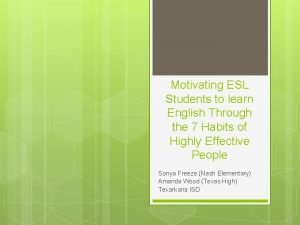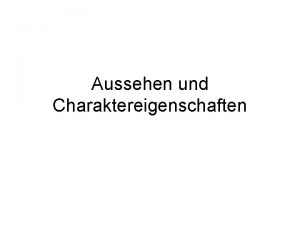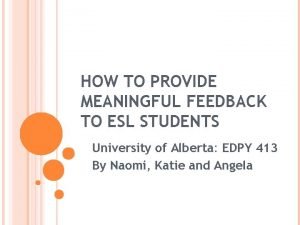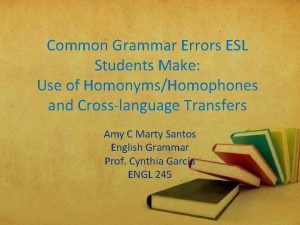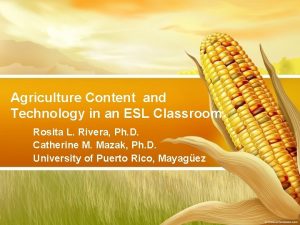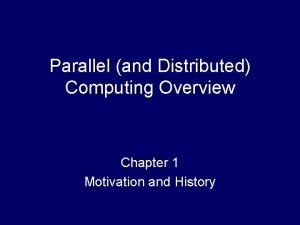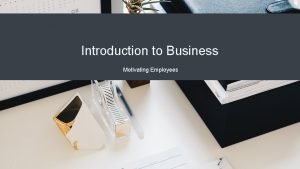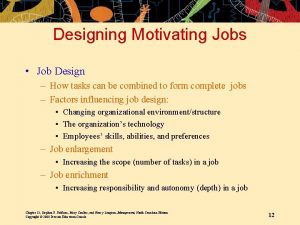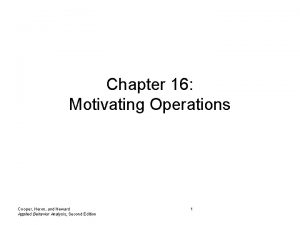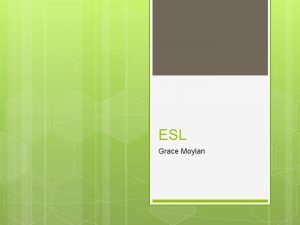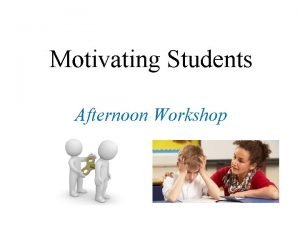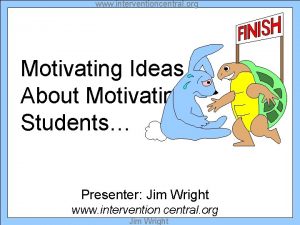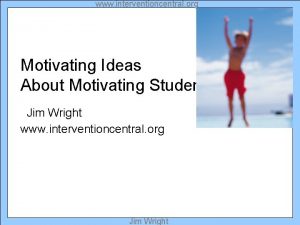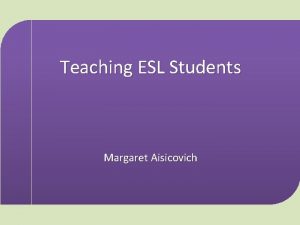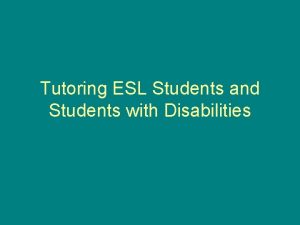Motivating ESL Students through Technology Valerie Traurig valerie










- Slides: 10

____________________ Motivating ESL Students through Technology Valerie Traurig valerie. traurig@montgomerycollege. edu January, 2008

________________ Introduction _____________________ Proving and Improving Teaching and Learning • Building teaching/computing skills • Motivating ESL students • Proving?

________________ Contents _____________________ Proving and Improving Teaching and Learning Enhancing regular ESL class with computer technology • • • Administration Computing Skills Self-directed/Self-regulated Group Work Multimedia

________________ Administration _____________________ Using an LMS/ CMS Web. CT, Blackboard, Moodle • Central place for course information/resources -- Syllabus/Schedule -- Announcements -- Scanned homework -- Optional exercises -- Email -- Grades • Teacher/student convenience • Student responsibility/empowerment • http: //webct. montgomerycollege. edu EL 103 RD 101 ID: ELGuest PW: ELGuest ID: RDGuest PW: RDGuest

________________ Computer Skills _____________________ Developing/Improving Useful Computer Skills • Online dictionaries • Word processing Empowering students to self-assess --- Spelling/grammar checks Readability statistics Word count, Flesch Reading Ease, Flesch-Kincaid Grade Level • E-mail • Google searches – use of URLs

________________ Self-directed/Self-regulated Learning _____________________ Degrees of Scaffolding • Web link exercises • Simple types of exercises A 4 ESL – http: //a 4 esl. org/c/qw. html Basic paragraph readings Quia -- http: //www. quia. com Hot Potatoes -- http: //hotpot. uvic. ca/ • More advanced -- LMS/CMS quizzes/assessments Power. Point with voice: subject/verb agreement self-study -- Javascript exercises http: //www. valerietraurig. com/ESL/writing/Mod 2/Cause/cause_contents. htm http: //mysite. verizon. net/valerietraurig/tsent_recognition. htm http: //mysite. verizon. net/valerietraurig/paragraph_quiz. html

________________ Group Work _____________________ Constructivism: collaborative learning • Group grammar/reading exercises Modals Advanced reading exercises • Group paragraph activities http: //www. valerietraurig. com/ESL/writing/Mod 2/Enumeration/enum_group. htm http: //www. valerietraurig. com/ESL/writing/Mod 2/Enumeration/enum_revision. htm • Webquests for real world context Cause/effect paragraphs dealing with global warming

________________ Multimedia _____________________ Howard Gardner’s Multiple Intelligences • Graphics Simple/animated images or pictures • Audio/Music -- ESL Blues: Doubling final consonants http: //ww 2. college-em. qc. ca/prof/epritchard/agdouble. htm -- Power. Point with audio: subject/verb agreement self-study -- Captivate/Camtasia: Readability Statistics tutorial • Video Talking head video – Logitech camera Existing videos – The B. O. O. K. www. youtube. com

________________ Conclusion _____________________ • Student motivation through technology Student feedback -- open discussion -- student survey Observation of students • Training Sources TESOL’s Principles and Practices of Online Teaching Certificate Program http: //www. tesol. org/s_tesol/sec_document. asp? CID=244&DID=487 George Washington University: Educational Technology Leadership http: //www. gwu. edu/~etl/

________________ Bibliography _____________________ Azevedo, R. (2005). Using hypermedia as a metacognitive tool for enhancing student learning? The role of selfregulated learning. Education Psychologist, 40(4), 199 -209. Bransford, J. D. , Brown, A. L. & Cocking, R. R. (1999). How people learn: Brain, nind, experience, and school. Chapter 9: Technology to support learning. Retrieved January 2008, from http: //books. nap. edu/html/howpeople 1/ Fouts, J. T. (2000). Research on computers and education: Past, present and future. Study prepared for the Bill and Melinda Gates Foundation. Retrieved January 3, 2005, from http: //www. portical. org/fouts. pdf Harvey, L. (2004). Analytic Quality Glossary: Empowerment. Quality Research International. Retrieved January 4, 2008, from http: //www. qualityresearchinternational. com/glossary/ Ju, J. (2001). Computer technology in the ESL/EFL writing classroom: Impacts on teachers. Retrieved January 20, 2007, from http: //lc. ust. hk/~centre/conf 2001/proceed/zhanj. pdf Mc. Vey, D. (2005, November/December). Writing in a team spirit. ESL Magazine, 48, 21. Schunk, D. H. (2005). Self-regulated learning: The educational legacy of Paul Pintrich. Educational Psychologist, 40(2), 85 -94. Thirteen. (2004). Concept to classroom: Constructivism as a paradigm for teaching and learning. Retrieved January 5, 2008, from http: //www. thirteen. org/edonline/concept 2 class/constructivism/index. html Thirteen. (2004). Concept to classroom: Tapping into multiple intelligences. January 5, 2008, from http: //www. thirteen. org/edonline/concept 2 class/mi/index. html Zimmerman, B. J. , & Tsikalas, E. (2005). Can computer-based learning environments (CBLES) be used as selfregulatory tools to enhance learning? Education Psychologist, 40(4), 267 -271.
